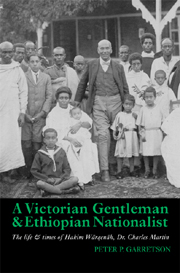 A Victorian Gentleman and Ethiopian Nationalist
A Victorian Gentleman and Ethiopian Nationalist Book contents
- Frontmatter
- Contents
- List of Illustrations
- Transliteration
- Note on the Ethiopian Calendar
- Glossary
- Acknowledgements
- Map 1 Ethiopia 1900–1950
- Map 2 Burma 1898–1919
- Introduction
- 1 Youth & education
- 2 Return to Ethiopia (1896–1901)
- 3 Campaigning in the Ogaden & return to Burma (1901–1907)
- 4 Transitions in life
- 5 A man of substance in Ethiopia & Burma
- 6 Return of a progressive to Addis Ababa (1919–1924)
- 7 An increased pace of modernization (1924–1930)
- 8 International diplomacy, education & recruitment
- 9 Governor of a model province, Chärchär (1930–1935)
- 10 Ethiopian ambassador to the Court of St. James (1935–1936)
- 11 London & India
- 12 Ethiopia
- Conclusion
- Bibliography
- Index
10 - Ethiopian ambassador to the Court of St. James (1935–1936)
Published online by Cambridge University Press: 05 April 2013
- Frontmatter
- Contents
- List of Illustrations
- Transliteration
- Note on the Ethiopian Calendar
- Glossary
- Acknowledgements
- Map 1 Ethiopia 1900–1950
- Map 2 Burma 1898–1919
- Introduction
- 1 Youth & education
- 2 Return to Ethiopia (1896–1901)
- 3 Campaigning in the Ogaden & return to Burma (1901–1907)
- 4 Transitions in life
- 5 A man of substance in Ethiopia & Burma
- 6 Return of a progressive to Addis Ababa (1919–1924)
- 7 An increased pace of modernization (1924–1930)
- 8 International diplomacy, education & recruitment
- 9 Governor of a model province, Chärchär (1930–1935)
- 10 Ethiopian ambassador to the Court of St. James (1935–1936)
- 11 London & India
- 12 Ethiopia
- Conclusion
- Bibliography
- Index
Summary
The period of the Italian invasion of Ethiopia from 1935 to 1940, marks the climax of Wärqenäh's career. From his arrival in London in July, 1935 he proved to be a hard working and talented ambassador for Ethiopia who not only transformed Ethiopia's relationship with Great Britain but also mobilized a wider, global audience encompassing: the British Empire (especially India), Europe, Africa, the worldwide African Diaspora and the Middle East. He was at the center of Ethiopia's efforts to counter Italian propaganda and played a significant role in the Ethiopian negotiations to raise money via loans to pay for the arms to resist Italy's invasion. A strong case can be made for Wärqenäh's being Ethiopia's most effective ambassador before World War II. During his early tenure as ambassador he had close relations with Emperor Haylä Sellassé, but they became increasingly strained, as we shall see. A good deal of his time was focused on his family, on caring for his four youngest children (brought with him from Ethiopia after his divorce) and also members of his extended adoptive family and the family of his eldest son's mother. Throughout this period he had a greater impact globally than in any other period of his life.
One of the most fascinating aspects of his ambassadorship was his ability not only to mobilize British public opinion in support of Ethiopia, but also to raise significant amounts of money to support her cause. He probably raised more money overseas for Ethiopia than any other single individual (except the emperor), in Europe, the United States, the West Indies, and Africa.
- Type
- Chapter
- Information
- A Victorian Gentleman and Ethiopian NationalistThe Life and Times of Hakim Wärqenäh, Dr. Charles Martin, pp. 204 - 236Publisher: Boydell & BrewerPrint publication year: 2012
